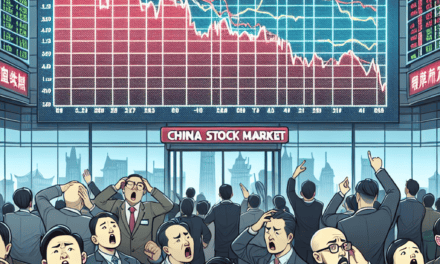“Navigate the Markets: Your Weekly Guide to Insights and Predictions”
Introduction
The Weekly Market Outlook provides a comprehensive analysis of the financial markets, offering key insights and predictions to help investors navigate the ever-changing economic landscape. This report delves into the latest trends across various asset classes, including equities, bonds, commodities, and currencies, while examining the macroeconomic factors influencing market movements. By leveraging expert analysis and data-driven forecasts, the Weekly Market Outlook aims to equip investors with the knowledge needed to make informed decisions, anticipate potential risks, and capitalize on emerging opportunities in the global markets.
Analyzing Stock Market Trends: What to Watch This Week
As we delve into the intricacies of the stock market this week, investors and analysts alike are keenly observing several key trends that could significantly influence market dynamics. The stock market, a complex and ever-evolving entity, requires a nuanced understanding of both macroeconomic indicators and sector-specific developments. This week, several factors are poised to shape market movements, and understanding these can provide valuable insights for investors seeking to navigate the financial landscape.
To begin with, the global economic outlook remains a pivotal factor in shaping market sentiment. Recent data releases have painted a mixed picture, with some economies showing signs of resilience while others grapple with persistent challenges. For instance, the U.S. economy continues to exhibit robust growth, buoyed by strong consumer spending and a resilient labor market. However, concerns about inflationary pressures and potential interest rate hikes by the Federal Reserve linger, creating an atmosphere of uncertainty. Investors will be closely monitoring any statements from Fed officials this week, as these could provide clues about the central bank’s future policy direction.
In addition to macroeconomic factors, corporate earnings reports are set to play a crucial role in influencing stock prices. As we enter the heart of the earnings season, companies across various sectors will be releasing their quarterly results. Analysts will be scrutinizing these reports not only for earnings figures but also for forward guidance and management commentary. Sectors such as technology and healthcare, which have been at the forefront of market gains in recent months, will be under particular scrutiny. Any deviation from expected performance in these sectors could lead to significant market volatility.
Moreover, geopolitical developments continue to be a source of concern for market participants. Ongoing tensions in various regions, coupled with trade negotiations and policy shifts, have the potential to impact global supply chains and investor confidence. This week, attention will be focused on any developments in trade talks between major economies, as well as any geopolitical events that could disrupt market stability. Investors will need to remain vigilant and adaptable, as geopolitical risks can often lead to sudden and unpredictable market movements.
Furthermore, technological advancements and innovations are reshaping industries and creating new investment opportunities. The rapid pace of technological change, particularly in areas such as artificial intelligence, renewable energy, and digital finance, is driving significant shifts in market dynamics. Investors are increasingly looking towards companies that are at the forefront of these innovations, as they are likely to benefit from long-term growth prospects. This week, any announcements or developments related to technological breakthroughs could capture investor attention and influence market trends.
In conclusion, the stock market this week is poised to be influenced by a confluence of factors, ranging from macroeconomic indicators and corporate earnings to geopolitical developments and technological advancements. Investors must remain informed and agile, as the interplay of these elements can create both opportunities and challenges. By closely monitoring these trends and staying attuned to market signals, investors can better position themselves to navigate the complexities of the financial markets and make informed decisions. As always, a balanced approach that considers both short-term fluctuations and long-term potential is essential for successful investing in an ever-changing market environment.
Currency Fluctuations: Key Drivers and Predictions
In the ever-evolving landscape of global finance, currency fluctuations remain a focal point for investors, policymakers, and businesses alike. Understanding the key drivers behind these fluctuations is essential for making informed decisions and anticipating future trends. This week, several factors are poised to influence currency movements, offering both challenges and opportunities for market participants.
To begin with, economic indicators continue to play a pivotal role in shaping currency values. Recent data releases, such as employment figures, inflation rates, and GDP growth, have provided mixed signals about the health of major economies. For instance, stronger-than-expected job growth in the United States has bolstered the dollar, as it suggests a resilient economy that may prompt the Federal Reserve to maintain or even increase interest rates. Conversely, weaker economic performance in the Eurozone has exerted downward pressure on the euro, as investors anticipate potential monetary easing by the European Central Bank.
In addition to economic data, geopolitical developments are exerting significant influence on currency markets. Ongoing trade negotiations, particularly between major economies like the United States and China, have introduced a layer of uncertainty that can lead to volatility. Any progress or setbacks in these discussions are likely to be reflected in currency valuations, as traders adjust their positions based on perceived risks and opportunities. Moreover, political events such as elections or policy shifts in key countries can also trigger fluctuations, as they may alter the economic landscape and investor sentiment.
Another critical factor to consider is the role of central banks in managing currency stability. Central banks wield considerable power through their monetary policy decisions, which can include interest rate adjustments, quantitative easing, or direct intervention in foreign exchange markets. This week, market participants will be closely monitoring statements and actions from central banks around the world, as any indication of a shift in policy could have immediate and far-reaching effects on currency values. For example, a surprise rate cut by a major central bank could lead to a depreciation of its currency, while a more hawkish stance might result in appreciation.
Furthermore, global risk sentiment is an overarching theme that influences currency movements. In times of heightened uncertainty or market stress, investors often seek safe-haven currencies such as the US dollar or the Swiss franc, leading to appreciation in these currencies. Conversely, when risk appetite increases, there is typically a shift towards higher-yielding or emerging market currencies, which can result in depreciation of traditional safe havens. This dynamic underscores the importance of monitoring broader market trends and investor behavior, as they can provide valuable insights into potential currency trajectories.
Looking ahead, predictions for currency movements must account for the interplay of these various factors. While short-term fluctuations are inevitable, understanding the underlying drivers can help market participants anticipate longer-term trends. Analysts suggest that continued economic divergence between major economies, coupled with geopolitical uncertainties, will likely sustain volatility in currency markets. As such, maintaining a vigilant approach and staying informed about key developments will be crucial for navigating the complex and dynamic world of currency trading.
In conclusion, currency fluctuations are driven by a myriad of factors, including economic indicators, geopolitical events, central bank policies, and global risk sentiment. By closely monitoring these elements, market participants can gain valuable insights into potential currency movements and make informed predictions. As the week unfolds, staying attuned to these drivers will be essential for successfully navigating the challenges and opportunities that lie ahead in the currency markets.
Commodity Market Movements: Insights for the Upcoming Week
As we delve into the commodity market movements for the upcoming week, it is essential to consider the various factors that are poised to influence these markets. The commodity sector, known for its volatility, is often swayed by a myriad of elements ranging from geopolitical tensions to weather patterns. This week, several key insights and predictions can be drawn from current trends and data, providing a clearer picture of what market participants might expect.
To begin with, the energy sector remains a focal point, particularly with crude oil prices experiencing fluctuations due to ongoing geopolitical developments. Recent tensions in the Middle East have led to concerns over supply disruptions, which in turn have caused a ripple effect on oil prices. Analysts suggest that any escalation in these tensions could further drive prices upward, while diplomatic resolutions might stabilize the market. Additionally, the upcoming OPEC meeting is anticipated to play a crucial role in determining production levels, which will inevitably impact global oil prices. Market participants should closely monitor these developments, as they are likely to set the tone for the energy market in the coming week.
Transitioning to the agricultural commodities, weather conditions continue to be a significant determinant of market movements. The recent reports of adverse weather patterns in key producing regions have raised concerns over crop yields, particularly for grains such as wheat and corn. These concerns have already led to a noticeable uptick in prices, as traders brace for potential supply shortages. Furthermore, the ongoing La Niña phenomenon is expected to exacerbate these conditions, potentially leading to further price volatility. As such, stakeholders in the agricultural sector should remain vigilant, keeping an eye on weather forecasts and their potential implications on crop production.
In the realm of precious metals, gold and silver have garnered attention as investors seek safe-haven assets amidst economic uncertainties. The recent fluctuations in global stock markets, coupled with concerns over inflationary pressures, have bolstered the appeal of these metals. Gold, in particular, has seen a steady increase in demand, as it is traditionally viewed as a hedge against inflation. As central banks around the world continue to navigate monetary policy adjustments, the trajectory of interest rates will be a critical factor influencing the precious metals market. Investors should consider these dynamics when making decisions, as they could significantly impact the demand and pricing of gold and silver.
Moreover, industrial metals such as copper and aluminum are also under the spotlight, driven by ongoing supply chain challenges and robust demand from the manufacturing sector. The global push towards renewable energy and electric vehicles has heightened demand for these metals, further straining supply chains already impacted by logistical disruptions. As manufacturers strive to meet production targets, any developments in supply chain management or changes in demand could lead to notable shifts in prices. Therefore, market participants should remain attuned to these factors, as they are likely to shape the industrial metals market in the near term.
In conclusion, the commodity markets are poised for a dynamic week ahead, influenced by a confluence of geopolitical, environmental, and economic factors. By staying informed and closely monitoring these developments, market participants can better navigate the complexities of the commodity sector, making informed decisions that align with their strategic objectives. As always, a keen understanding of the underlying drivers will be essential for anticipating market movements and capitalizing on emerging opportunities.
Interest Rate Changes: Implications for Investors

In the ever-evolving landscape of global finance, interest rate changes remain a pivotal factor influencing investment decisions. As central banks around the world adjust their monetary policies in response to economic indicators, investors must stay informed about the implications of these changes. This week, the focus is on understanding how recent interest rate adjustments could impact various asset classes and what strategies investors might consider to navigate this complex environment.
To begin with, interest rates are a fundamental tool used by central banks to control inflation and stabilize the economy. When rates are increased, borrowing costs rise, which can slow down consumer spending and business investment. Conversely, lower rates tend to stimulate economic activity by making borrowing cheaper. In the current economic climate, characterized by fluctuating inflation rates and uneven economic recovery post-pandemic, central banks are carefully calibrating their interest rate policies. For investors, these changes can have profound implications on portfolio performance.
One of the most immediate effects of interest rate changes is observed in the bond market. Typically, when interest rates rise, bond prices fall, and yields increase. This inverse relationship means that existing bonds with lower yields become less attractive compared to new issues offering higher returns. Consequently, investors holding long-term bonds may experience a decline in the market value of their holdings. However, for those looking to invest in bonds, rising rates can present an opportunity to acquire new bonds with better yields, potentially enhancing future income streams.
In the equity markets, the impact of interest rate changes can be multifaceted. Higher interest rates often lead to increased borrowing costs for companies, which can squeeze profit margins and dampen stock prices. Sectors that are heavily reliant on debt, such as utilities and real estate, may be particularly vulnerable. On the other hand, financial institutions like banks might benefit from rising rates, as they can charge more for loans, potentially boosting their profitability. Therefore, investors may need to reassess their sector allocations and consider rotating into industries that are better positioned to thrive in a higher interest rate environment.
Moreover, interest rate changes can also influence currency markets. Generally, higher interest rates attract foreign capital, leading to an appreciation of the domestic currency. This can have a ripple effect on international investments and trade balances. For investors with exposure to foreign markets, currency fluctuations can add an additional layer of risk or opportunity, depending on the direction of the rate changes and the relative strength of different currencies.
In light of these dynamics, investors are advised to adopt a proactive approach. Diversification remains a key strategy to mitigate risks associated with interest rate volatility. By spreading investments across various asset classes and geographies, investors can potentially cushion their portfolios against adverse movements in any single market. Additionally, maintaining a flexible investment strategy that can adapt to changing economic conditions is crucial. This might involve adjusting the duration of bond holdings, re-evaluating equity sector exposures, or considering alternative investments that are less sensitive to interest rate changes.
In conclusion, as central banks continue to navigate the delicate balance between fostering economic growth and controlling inflation, interest rate changes will remain a significant factor for investors to monitor. By understanding the implications of these changes and adjusting their strategies accordingly, investors can better position themselves to achieve their financial objectives in an uncertain economic landscape.
Global Economic Indicators: What They Mean for Markets
In the ever-evolving landscape of global markets, understanding economic indicators is crucial for investors and analysts alike. These indicators serve as vital tools, offering insights into the health and direction of economies worldwide. As we delve into this week’s market outlook, it is essential to consider the implications of recent data releases and their potential impact on financial markets.
To begin with, the latest figures on global GDP growth have been a focal point for market participants. Recent reports suggest a mixed picture, with some regions experiencing robust growth while others face stagnation. For instance, emerging markets in Asia have shown resilience, driven by strong domestic demand and export performance. Conversely, several European economies are grappling with slower growth, attributed to geopolitical tensions and supply chain disruptions. This divergence in economic performance is likely to influence investor sentiment, prompting a shift in capital flows towards more promising regions.
Moreover, inflation remains a critical concern for global markets. Recent data indicates that inflationary pressures persist, albeit with varying intensity across different economies. In the United States, inflation has shown signs of moderation, providing some relief to policymakers and investors. However, in other parts of the world, particularly in developing economies, inflation continues to pose challenges, eroding purchasing power and complicating monetary policy decisions. As central banks navigate this complex landscape, their policy responses will be closely monitored by market participants, as they hold significant implications for interest rates and asset valuations.
In addition to GDP and inflation, labor market indicators are also under scrutiny. The latest employment data reveals a nuanced picture, with some economies witnessing robust job creation while others struggle with high unemployment rates. In the United States, for example, the labor market remains relatively strong, with unemployment rates near historic lows. This has bolstered consumer confidence and spending, supporting economic growth. However, in other regions, labor market recovery has been uneven, with structural challenges hindering progress. These disparities in employment trends are likely to influence consumer behavior and, by extension, corporate earnings and stock market performance.
Furthermore, geopolitical developments continue to cast a shadow over global markets. Recent tensions in Eastern Europe and the Middle East have heightened uncertainty, leading to increased volatility in commodity prices and currency markets. Investors are closely watching these developments, as they have the potential to disrupt trade flows and economic stability. In response, some investors may seek refuge in safe-haven assets, such as gold and government bonds, while others may adopt a more cautious approach, reassessing their risk exposure.
As we look ahead, it is clear that global economic indicators will play a pivotal role in shaping market dynamics. Investors and analysts must remain vigilant, keeping a close eye on data releases and policy announcements. By understanding the interplay between these indicators and market trends, they can make informed decisions, navigating the complexities of the global financial landscape. In conclusion, while challenges remain, opportunities abound for those who can adeptly interpret the signals provided by economic indicators, positioning themselves strategically in an ever-changing market environment.
Sector-Specific Outlook: Opportunities and Risks
In the ever-evolving landscape of global markets, sector-specific analysis provides invaluable insights into potential opportunities and risks. As we delve into the upcoming week, it is crucial to examine the dynamics within various sectors to better understand the forces at play and anticipate potential shifts. The technology sector, for instance, continues to be a focal point for investors, driven by rapid advancements and increasing digital transformation across industries. However, it is essential to remain cognizant of the regulatory challenges and geopolitical tensions that could impact this sector. As governments worldwide scrutinize data privacy and antitrust issues, companies may face increased compliance costs and operational hurdles, which could affect their profitability and market valuations.
Transitioning to the energy sector, the ongoing transition towards renewable energy sources presents both opportunities and risks. On one hand, the push for sustainability and the global commitment to reducing carbon emissions have spurred investments in clean energy technologies. This shift is likely to benefit companies involved in solar, wind, and other renewable energy projects. On the other hand, traditional energy companies may encounter challenges as they adapt to changing regulations and market demands. Fluctuations in oil prices, driven by geopolitical factors and supply chain disruptions, further add to the complexity of navigating this sector.
Meanwhile, the healthcare sector remains a critical area of focus, particularly in light of recent global health challenges. The demand for innovative healthcare solutions and pharmaceuticals continues to rise, offering growth prospects for companies that can deliver effective treatments and technologies. However, the sector is not without its risks. Regulatory scrutiny, pricing pressures, and the need for substantial research and development investments can pose significant challenges. Additionally, the ongoing debate over healthcare reform in various countries may introduce uncertainties that could impact market dynamics.
In the financial sector, the interplay between interest rates, inflation, and economic growth remains a key consideration. Central banks’ monetary policies and their responses to inflationary pressures will likely influence the performance of financial institutions. While rising interest rates can enhance banks’ net interest margins, they may also dampen loan demand and increase default risks. Furthermore, the growing adoption of fintech solutions and digital banking platforms presents both opportunities for innovation and competitive pressures for traditional financial institutions.
Turning our attention to the consumer goods sector, shifting consumer preferences and supply chain disruptions are pivotal factors to monitor. The increasing emphasis on sustainability and ethical sourcing is driving companies to adapt their business models and product offerings. Those that can successfully align with these trends may capture market share and enhance brand loyalty. However, supply chain challenges, exacerbated by geopolitical tensions and pandemic-related disruptions, pose risks to production and distribution capabilities.
In conclusion, while each sector presents unique opportunities and risks, a comprehensive understanding of these dynamics is essential for informed decision-making. Investors and stakeholders must remain vigilant, continuously assessing the impact of regulatory changes, technological advancements, and macroeconomic factors on sector performance. By doing so, they can better position themselves to capitalize on emerging opportunities while mitigating potential risks. As we navigate the complexities of the global market, a sector-specific outlook provides a valuable lens through which to anticipate and respond to the ever-changing economic landscape.
Geopolitical Events: Potential Market Impacts This Week
In the ever-evolving landscape of global finance, geopolitical events play a pivotal role in shaping market dynamics. This week, investors and analysts alike are closely monitoring several key geopolitical developments that could significantly impact financial markets. As tensions simmer in various regions, the potential for market volatility remains high, necessitating a keen understanding of these events and their possible repercussions.
To begin with, the ongoing conflict in Eastern Europe continues to be a focal point for market participants. The situation remains fluid, with diplomatic efforts to resolve tensions showing limited progress. Any escalation in hostilities could lead to increased volatility in energy markets, particularly affecting oil and natural gas prices. Europe’s reliance on energy imports from the region underscores the potential for supply disruptions, which could, in turn, drive up prices and impact inflationary pressures globally. Investors should remain vigilant, as shifts in energy prices often have a cascading effect on various sectors, including transportation and manufacturing.
Meanwhile, in the Asia-Pacific region, the geopolitical landscape is equally complex. The recent developments in the South China Sea have heightened tensions between major powers, raising concerns over potential disruptions to one of the world’s busiest maritime trade routes. Any significant escalation could have far-reaching implications for global trade, potentially affecting supply chains and leading to increased costs for businesses reliant on these routes. Consequently, companies with significant exposure to Asia-Pacific markets may experience heightened risk, prompting investors to reassess their portfolios in light of these developments.
In addition to regional conflicts, the global economic landscape is also being shaped by ongoing trade negotiations. The recent talks between major economies have been closely watched, as any breakthroughs or setbacks could influence market sentiment. A successful resolution to trade disputes could bolster investor confidence, leading to a rally in equities and a strengthening of currencies tied to export-driven economies. Conversely, a breakdown in negotiations might trigger a flight to safety, with investors seeking refuge in traditional safe-haven assets such as gold and government bonds.
Furthermore, the upcoming meetings of international organizations, such as the G20 summit, are expected to provide further insights into the geopolitical climate. These gatherings offer a platform for world leaders to address pressing global issues, including economic cooperation and climate change. The outcomes of these discussions could have significant implications for market trends, particularly if new policies or agreements are announced. Investors should pay close attention to any statements or communiqués issued during these meetings, as they often provide valuable clues about future policy directions.
As we navigate through this week, it is crucial for market participants to remain informed about these geopolitical events and their potential impacts. By staying abreast of developments and understanding the interconnectedness of global markets, investors can better position themselves to manage risks and capitalize on opportunities. In conclusion, while geopolitical events present challenges, they also offer a chance for astute investors to gain insights and make informed decisions. As the week unfolds, maintaining a balanced perspective and a proactive approach will be key to navigating the complexities of the current market environment.
Q&A
1. **What is the current trend in the stock market?**
– The stock market is experiencing a mixed trend with some sectors showing growth while others face volatility due to economic uncertainties.
2. **Which sectors are expected to perform well this week?**
– Technology and healthcare sectors are expected to perform well due to strong earnings reports and increased demand.
3. **What economic indicators should investors watch this week?**
– Investors should watch for updates on inflation rates, unemployment figures, and consumer confidence indices.
4. **How are geopolitical events impacting the market?**
– Geopolitical tensions, particularly in regions with significant trade relationships, are causing market fluctuations and investor caution.
5. **What is the outlook for interest rates?**
– Interest rates are expected to remain stable, but any unexpected changes by central banks could impact market dynamics.
6. **Are there any significant earnings reports to watch?**
– Major companies in the tech and financial sectors are releasing earnings reports, which could influence market sentiment.
7. **What is the forecast for commodity prices?**
– Commodity prices, particularly oil and gold, are expected to remain volatile due to supply chain issues and global demand shifts.
Conclusion
The Weekly Market Outlook provides a comprehensive analysis of current market trends, highlighting key insights and offering predictions for the near future. It identifies significant economic indicators, geopolitical events, and sector-specific developments that are likely to influence market movements. The report suggests a cautious approach due to potential volatility, while also identifying opportunities for growth in emerging markets and technology sectors. Overall, the outlook emphasizes the importance of staying informed and adaptable in response to rapidly changing market conditions.





